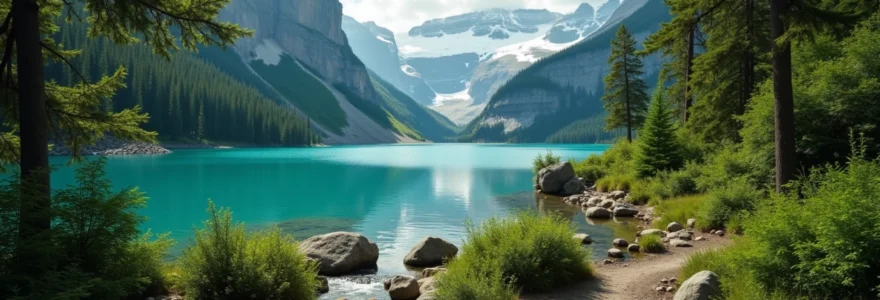For those who find solace in the great outdoors and thrill in exploring Earth’s most spectacular landscapes, the world offers an abundance of breathtaking destinations. From lush rainforests teeming with unique wildlife to rugged mountain ranges that challenge even the most seasoned climbers, nature’s wonders await at every turn. This comprehensive guide delves into the planet’s most extraordinary natural sites, perfect for adventurers, conservationists, and anyone with a passion for the wild.
Biodiversity hotspots: exploring earth’s most ecologically rich destinations
Biodiversity hotspots are regions characterized by exceptional concentrations of plant and animal species, many of which are found nowhere else on Earth. These areas are not only crucial for conservation efforts but also offer unparalleled experiences for nature enthusiasts. Let’s explore some of the most remarkable biodiversity hotspots around the globe.
Costa rica’s monteverde cloud forest reserve: habitat of the resplendent quetzal
Nestled in the Cordillera de Tilarán mountain range, the Monteverde Cloud Forest Reserve is a mystical realm of mist-shrouded forests and incredible biodiversity. This 26,000-acre reserve is home to over 100 species of mammals, 400 bird species, and a staggering 2,500 plant species. The star attraction for many visitors is the elusive resplendent quetzal, a bird revered by ancient Mesoamerican civilizations for its vibrant plumage.
As you traverse the reserve’s well-maintained trails, you’ll find yourself immersed in a world of epiphytes, orchids, and towering trees draped in moss. The constant presence of mist and clouds creates a uniquely ethereal atmosphere, making every step feel like a journey through a living, breathing ecosystem.
The Monteverde Cloud Forest Reserve is not just a haven for wildlife, but a testament to the power of conservation. Its establishment in 1972 marked a turning point in Costa Rica’s approach to environmental protection.
Madagascar’s ranomafana national park: home to critically endangered lemur species
Madagascar, often referred to as the “eighth continent” due to its unique flora and fauna, boasts some of the world’s most diverse and threatened ecosystems. Ranomafana National Park, a UNESCO World Heritage site, exemplifies this biodiversity in its 161 square miles of tropical rainforest. The park is particularly renowned for its lemur populations, including the critically endangered golden bamboo lemur, which was only discovered in 1986.
Trekking through Ranomafana offers visitors the chance to spot 12 lemur species, over 130 frog species, and a plethora of chameleons and other reptiles. The park’s varied elevations, ranging from 1,600 to 4,600 feet, create distinct microclimates that support an incredible array of plant life, including many species used in traditional Malagasy medicine.
Ecuador’s galápagos islands: darwin’s living laboratory of evolution
The Galápagos Islands, an archipelago of volcanic islands straddling the equator, are synonymous with Charles Darwin’s theory of evolution by natural selection. This living laboratory continues to astound scientists and visitors alike with its unique array of endemic species, many of which have evolved in isolation for millions of years.
From the iconic Galápagos giant tortoise to marine iguanas and flightless cormorants, the islands offer unparalleled opportunities for wildlife observation. The surrounding waters, part of the Galápagos Marine Reserve, are equally rich in biodiversity, hosting hammerhead sharks, whale sharks, and a variety of ray species.
Visitors can explore the islands through guided tours, snorkeling expeditions, and carefully managed hiking trails, all designed to minimize human impact on these fragile ecosystems.
Extreme adventure landscapes: challenging terrains for adrenaline seekers
For those who seek to test their limits in nature’s most demanding environments, the world offers a multitude of extreme landscapes. These destinations combine breathtaking scenery with physical challenges that push adventurers to their limits.
Scaling the dolomites: via ferrata routes in italy’s dramatic alpine range
The Dolomites, a UNESCO World Heritage site in northeastern Italy, offer some of the most dramatic mountain scenery in Europe. What sets this range apart for adventurers is its extensive network of via ferrata routes. Italian for “iron path,” these protected climbing routes allow relatively inexperienced climbers to access high-altitude terrain typically reserved for expert mountaineers.
Via ferrata routes in the Dolomites range from beginner-friendly paths to extremely challenging routes that require significant strength and endurance. As you climb, you’ll be treated to panoramic views of jagged peaks, verdant valleys, and alpine meadows. The region’s unique geology, characterized by pale dolomite rock, creates a landscape that seems to glow at sunrise and sunset, a phenomenon known as enrosadira .
Trekking patagonia’s torres del paine circuit: navigating glaciers and windswept peaks
Patagonia’s Torres del Paine National Park in Chile is a wilderness of unparalleled beauty and challenge. The park’s crown jewel is the Torres del Paine Circuit, a 10-day trek that circles the Cordillera del Paine, offering views of towering granite spires, expansive ice fields, and pristine glacial lakes.
The circuit covers approximately 110 kilometers (68 miles) of varied terrain, from dense forests to windswept alpine passes. Trekkers must be prepared for rapidly changing weather conditions, with strong winds and sudden temperature drops common even in summer. The reward for this challenge is access to some of the most spectacular scenery on Earth, including the iconic granite towers that give the park its name.
Canyoneering utah’s zion national park: descending the narrows and subway
Zion National Park in Utah is renowned for its dramatic sandstone cliffs and narrow slot canyons, offering some of the best canyoneering opportunities in the world. Two of the park’s most famous routes are The Narrows and The Subway, each presenting unique challenges and breathtaking scenery.
The Narrows involves wading upstream through the Virgin River, surrounded by towering canyon walls that narrow to just 20 feet wide in places. The Subway, named for its tube-like formations, requires rappelling, swimming through cold pools, and navigating boulder fields. Both routes demand technical skills, proper equipment, and a good understanding of flash flood risks.
Canyoneering in Zion is not just about physical challenge; it’s an immersive journey through millions of years of geological history, where water has sculpted the landscape into a natural work of art.
Marine wonderlands: top destinations for underwater exploration
The world’s oceans cover more than 70% of the Earth’s surface and host an incredible diversity of life. For nature lovers and adventure seekers willing to don a mask and fins, these underwater realms offer experiences that rival any terrestrial landscape.
Australia’s great barrier reef: diving among 1,500 fish species and 400 coral types
Stretching over 2,300 kilometers (1,400 miles) along Australia’s northeastern coast, the Great Barrier Reef is the world’s largest coral reef system and one of the most biodiverse places on Earth. This underwater wonderland is home to over 1,500 species of fish, 400 types of hard coral, one-third of the world’s soft corals, and 134 species of sharks and rays.
Diving or snorkeling in the Great Barrier Reef offers encounters with an astonishing array of marine life, from tiny clownfish hiding in anemones to massive whale sharks gliding through the blue. The reef’s health is critical to global marine ecosystems, making it not just a destination for adventure but also a focal point for conservation efforts.
Indonesia’s raja ampat: epicenter of marine biodiversity in the coral triangle
Located off the northwest tip of Papua, Indonesia’s Raja Ampat archipelago is often described as the global epicenter of marine biodiversity. This remote region, consisting of over 1,500 small islands, cays, and shoals, lies at the heart of the Coral Triangle, an area known for its incredible variety of marine species.
Raja Ampat’s waters host more than 1,300 fish species, 600 coral species, and 700 mollusk species. Divers can explore pristine coral gardens, encounter massive manta rays at cleaning stations, and witness the unique phenomenon of walking sharks on night dives. The region’s relative isolation has helped preserve its ecosystems, making it a priority area for marine conservation efforts.
Palau’s jellyfish lake: snorkelling with millions of stingless mastigias papua jellyfish
For a truly unique underwater experience, few places can match Palau’s Jellyfish Lake. Located on Eil Malk Island, this marine lake is home to millions of golden jellyfish that have evolved in isolation for thousands of years. Due to the lack of predators in their enclosed environment, these jellyfish have lost their ability to sting, allowing snorkelers to safely swim among vast swarms.
The experience of floating in crystal-clear water surrounded by pulsating jellyfish is often described as otherworldly. Beyond the novelty, Jellyfish Lake offers insights into evolutionary processes and the delicate balance of isolated ecosystems. Access to the lake is carefully managed to protect this unique environment, making it a model for sustainable ecotourism.
Ancient forests: trekking through earth’s oldest living ecosystems
Ancient forests stand as living monuments to the Earth’s history, offering glimpses into ecosystems that have remained relatively unchanged for millions of years. These primeval woodlands not only provide habitats for countless species but also play crucial roles in carbon sequestration and climate regulation.
California’s redwood national park: walking among 2,000-Year-Old sequoia sempervirens
The coastal redwoods ( Sequoia sempervirens ) of Northern California are among the oldest and tallest living organisms on Earth. Redwood National Park, along with several state parks, protects significant portions of the remaining old-growth redwood forests, which once covered much of the Pacific Northwest.
Walking through groves of these giants, some of which have been standing for over 2,000 years, is a humbling experience. The tallest tree in the park, Hyperion, reaches a staggering height of 380.1 feet (115.92 meters). The forest floor is a world unto itself, with rich undergrowth, clear streams, and a diverse array of wildlife, including Roosevelt elk and numerous bird species.
Tasmania’s tarkine wilderness: exploring australia’s largest temperate rainforest
The Tarkine in northwestern Tasmania is Australia’s largest temperate rainforest and one of the world’s great wild places. This 447,000-hectare wilderness area is home to ancient myrtle forests, some with trees over 3,000 years old. The Tarkine also boasts pristine rivers, dramatic coastlines, and extensive cave systems.
Exploring the Tarkine offers opportunities to witness unique wildlife, including Tasmanian devils and spotted-tail quolls. The region’s rich Aboriginal heritage adds cultural depth to the natural wonders, with rock carvings and middens providing insights into the area’s long human history.
The Tarkine represents one of the last great wilderness areas on Earth, a living link to the ancient supercontinent of Gondwana and a testament to the importance of preserving our planet’s primeval landscapes.
Geological marvels: witnessing earth’s most spectacular formations
The Earth’s geological processes have created landscapes of breathtaking beauty and scientific significance. These formations offer windows into our planet’s past and ongoing geological activity, providing both visual spectacles and opportunities for deep learning about Earth’s history.
Iceland’s vatnajökull national park: traversing europe’s largest ice cap
Vatnajökull National Park, encompassing Europe’s largest ice cap outside the Arctic, is a land of stark contrasts and dynamic geological activity. The park’s centerpiece, the Vatnajökull glacier, covers an area of 8,100 square kilometers and reaches a thickness of 1,000 meters in places.
Visitors to the park can witness the interplay of ice and fire, with active volcanoes lurking beneath the glacial ice. Guided glacier walks, ice cave explorations, and super-jeep tours offer various ways to experience this unique landscape. The park also includes stunning waterfalls, such as Dettifoss, Europe’s most powerful waterfall, and the Jökulsárlón glacial lagoon, where icebergs calved from the glacier float serenely before drifting out to sea.
Usa’s bryce canyon: hiking through the world’s largest concentration of hoodoos
Bryce Canyon National Park in Utah is renowned for its otherworldly landscape of hoodoos—tall, thin spires of rock that rise from the canyon floor. The park boasts the world’s largest concentration of these unique formations, created by millions of years of erosion and frost wedging.
Hiking trails wind through amphitheaters filled with thousands of hoodoos, offering close-up views of these geological wonders. The park’s high elevation (up to 9,000 feet) provides excellent stargazing opportunities, with clear, dark skies revealing the Milky Way on moonless nights. Bryce Canyon’s distinct geological features and vibrant colors, especially at sunrise and sunset, make it a photographer’s paradise.
China’s zhangjiajie national forest park: scaling the ‘avatar mountains’ of hunan province
Zhangjiajie National Forest Park in China’s Hunan Province gained international fame as the inspiration for the floating mountains in James Cameron’s film “Avatar.” The park’s most distinctive features are its towering quartzite sandstone pillars, some of which rise over 1,000 meters from the forest floor.
Exploring Zhangjiajie offers a mix of natural beauty and engineering marvels. The Bailong Elevator, a 326-meter-tall glass elevator built into the side of a cliff, provides quick access to stunning viewpoints. For those seeking a more adventurous experience, hiking trails wind through the forested valleys and along precarious cliff edges, offering breathtaking views of the surreal landscape.
The park’s unique ecosystem supports a diverse array of flora and fauna, including several endangered species such as the Chinese giant salamander and the clouded leopard. This combination of geological wonders and rich biodiversity makes Zhangjiajie a must-visit destination for nature enthusiasts and adventure seekers alike.


